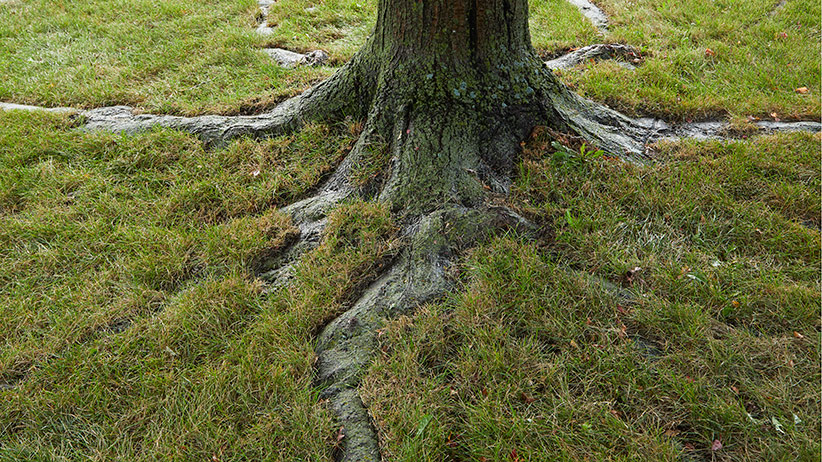Grow a water-wise garden with drought-tolerant flowers
If you’ve found yourself watering more than anticipated in the last several years, you’re not alone. With longer periods between rainfalls in many parts of the country, plants (and gardeners!) suffer. But with watering restrictions in many communities, the answer isn’t always to simply grab the hose. And who really wants to do that anyway? Using mulch to help retain moisture and watering deeply to encourage roots to stretch into the soil are a couple things you can do to help plants survive drought conditions. But ultimately, incorporating plants that can handle low-water is a smart long-term strategy to battle drought. We've picked 10 of our favorites for you to try here, keep reading to learn more!
Qualities of drought-tolerant plants
Growing plants that don’t need as much water is probably the best long-term fix. How do you know if a plant will be drought tolerant? There are a few telltale signs:
- Fleshy foliage, like that of succulents and cactus, stores water in their leaves for times when it isn’t available in the soil.
- Waxy leaf surfaces cut down on water loss and reflect heat away from the plant.
- Small thin leaves help reduce surface area, where water loss occurs.
- Tiny hairs, or trichomes, help protect plants from intense light and temperature.
- Thick, fleshy rhizomes and deep tap roots store moisture and nutrients for dry times.
You Might Also Like:
Watch Our Smart Gardening Videos
Save Water with a DIY Rain Barrel
Drought-Tolerant Sedum Combo
Meet 10 drought-tolerant flowers for your garden
Here are 10 plants that won’t have you stretching the hose every time there’s a dry spell. Keep in mind that when they’re new, all plants will need some extra water until they get established, but once they’re mature, these can take hot, dry stretches better than most. In fact, most of these plants prefer their soil on the dry side. So don’t grow them next to plants that need a lot of water, or one or the other won’t thrive.
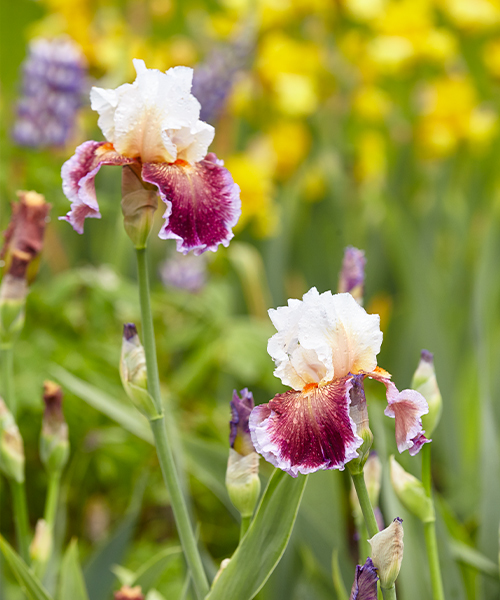
Bearded iris (Iris hybrids)
Bearded irises, once established, are incredibly drought tolerant, thanks to their large rhizomes, which allow these plants to store water and nutrients for future use. While mulch helps most plants in times of drought, bearded irises are an exception. Skip the mulch as it may hold too much moisture and cause rhizomes to rot. And shallow planting is key to keeping these plants happy.
Bearded irises come in many different sizes, from dwarf varieties, such as ‘Candy Dragon’, which reaches 8 inches in height, to the tallest ones, such as ‘Care to Dance’ pictured here, which is more than 27 inches tall. And there is a wide range of colors to choose from. Many varieties, such as ‘Care to Dance’, are bicolors, having different colors on their standards, or upright petals, and falls, or downward-facing petals.
Type Bulb Blooms Red, orange, yellow, blue, purple, brown, white, pink or bicolors in late spring through early summer Light Full sun to part shade Soil Average, well-drained Size 8 in. to 36 in. tall, 12 to 24 in. wide Hardiness Cold hardy in USDA zones 3 to 9 Source Schreiner’s Iris Gardens, schreinersgardens.com, 503-393-3232
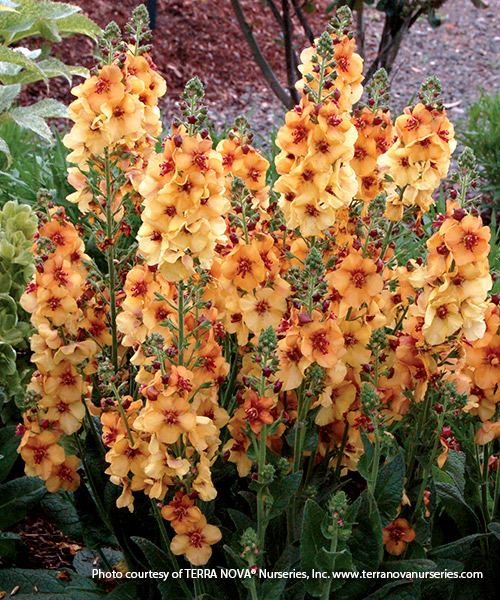
Mullein (Verbascum hybrids)
Mulleins are colorful, easy-to-grow perennials. Their long-lasting, skyrocketing spikes are hard to miss and bring a wow factor to the border. Plus, they make great cut flowers.
Although mulleins are typically known for yellow flowers, there are also other colors available. For example, ‘Honey Dijon’ pictured here displays shades of peach and gold, and ‘Cherry Helen’ has red-wine flowers and purple centers.
Plants have long, deep tap roots that improve water intake during periods of drought. Some mulleins are heavy seeders. To prevent unwanted reseeding, cut back spent flowers.
Type Perennial Blooms Yellow, white, purple, orange, red or pale pink flowers in late spring Light Full sun Soil Well drained to poor soil Size 1 to 8 ft. tall, 1 to 4 ft. wide Hardiness Cold hardy in USDA zones 5 to 11 Source Terra Nova Nurseries, terranovanurseries.com, 800-215-9450

Creeping thyme (Thymus serpyllum & Thymus praecox)
Creeping thyme is low growing and spreads rapidly where it’s happy. This plant is the perfect ground cover, border plant, lawn substitute or filler between garden spaces. It also grows well on rock walls or in stone pathways and can handle quite a bit of foot traffic.
As you step on it, the fragrance is released in the air. Its strong, aromatic scent makes this plant attractive to pollinators and wards off garden pests, making it a helpful addition to fruit and vegetable gardens and other spots where you have trouble with deer or rabbits.
Creeping thyme’s small, oval green leaves covered in tiny trichomes, or hairs, help protect the plant from intense light and temperatures. Flower colors come in showy pinks like ‘Pink Creeping Thyme’ (pictured above), lavender-red hues of ‘Red Creeping Carpet’, purples and soft whites. In the spring, prune by cutting back older, overgrown, leggy and thin stems to maintain a compact appearance.
Type Perennial Blooms White, red, pink or purple blooms from early to midsummer Light Full sun Soil Well-drained, lean Size 2 to 3 in. tall, 12 to 18 in. wide Hardiness Cold hardy in USDA zones 4 to 9 Source Local garden centers

Spike blazing star (Liatris spicata)
Spike blazing star is always the first flower to catch my eye in any garden because of its distinctive towering blooms. The flower spikes grow 1 to 5 feet in height, emerging from delicate grassy foliage and blooming from midsummer to fall.
Pollinators love spike blazing star’s purple or white flowers. Relative rough blazing star (L. aspera) is another great choice for drought-tolerant gardens. All blazing stars grow from corms and tuberous roots that store water and nutrients.
The fine-textured foliage remains attractive all summer and in fall, leaves and stalks turn a rich orange-bronze with wheat-colored seedheads. Spike blazing star is also a great addition to containers and cutting gardens because of its long-lasting flowers.
Type Perennial Blooms Purple, pink or white flower spikes in summer Light Full sun to part shade Soil Average, well-drained Size 18 to 48 in. tall, 12 to 24 in. wide Hardiness Cold hardy in USDA zones 3 to 9 Source Local garden centers
You Might Also Like:
Pollinator Garden Plant Combinations
Tips for Growing a Cut-Flower Garden
Travel to Gorgeous Gardens with Garden Gate Editors
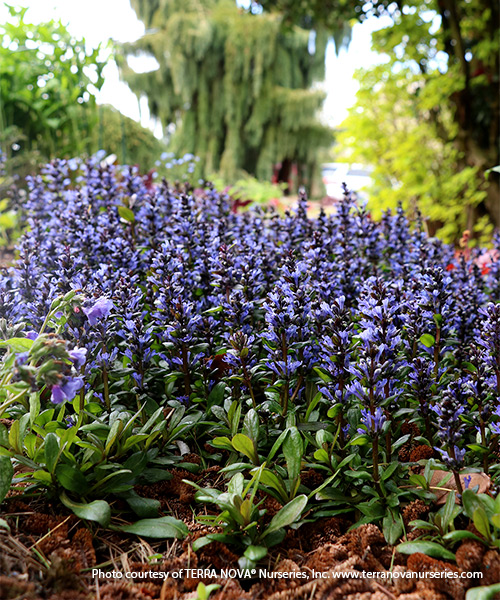
Bugleweed (Ajuga reptans)
Bugleweed makes a beautiful low-maintenance ground cover in sunny or shady beds, pathways, rock gardens, under shrubs and trees, and even containers. With a wide variety of foliage colors to choose from, finding a match for your garden should be a breeze.
For dramatic colors like deep blue flowers and green foliage with chocolate hues, plant ‘Blueberry Muffin’, pictured here. For a more subtle take, grow ‘Silver Beauty’, with light bicolor foliage and white spring flowers.
Bugleweed’s dense growth habit keeps weeds down, and it can fill an area quickly. However, because of this tendency to spread quickly, avoid planting bugleweed near lawns and double check with your local Extension office and Department of Natural Resources to see if it’s considered invasive or too aggressive in your state.
Type Perennial Blooms Purple, blue, white or pink flowers in spring Light Full sun to full shade Soil Well-drained or drier soils Size 4 to 10 in. tall, 10 to 24 in. wide Hardiness Cold hardy in USDA zones 3 to 9 Source Local garden centers
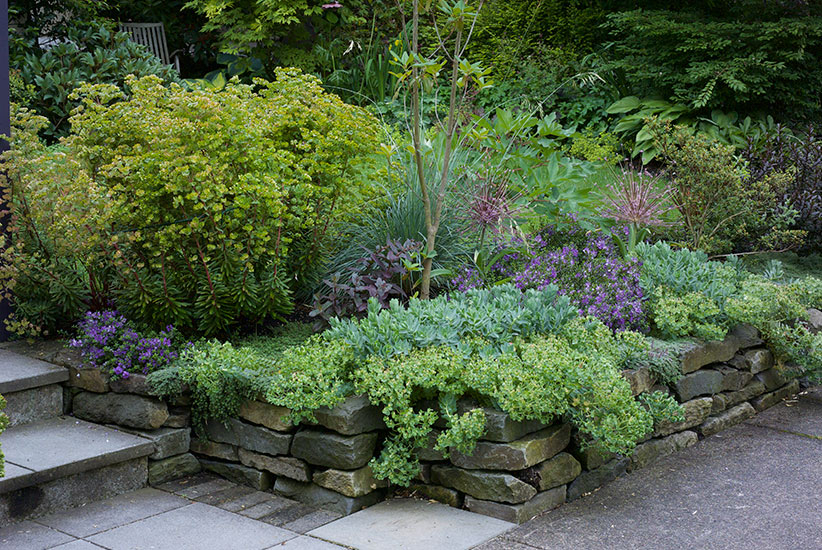
Myrtle spurge (Euphorbia myrsinites)
Myrtle spurge has a beautiful spreading habit that adds texture and drama to sunny spots in the garden. Very easy to care for and self-sufficient once established, it’s a great plant for beginners because it’s almost impossible to kill, so much so that it is advised to plant with caution: _It’s known for prolifically self-seeding; in fact, in the Mountain West, it’s been identified as aggressive and possibly even invasive.
It’s an excellent addition to borders, rock gardens, container plantings and meadows, forming dense mounds of whorled leaves with blue-green foliage. The showy yellow bracts hold their color for several weeks.
Precautions when planting myrtle spurge
Myrtle spurge doesn’t require much maintenance, but it’s important to note that stems and leaves ooze a toxic white sap when cut or broken. And plant with caution: _It’s known for prolifically self-seeding; in fact, in the Mountain West, it’s been identified as aggressive and possibly even invasive.
Type Perennial Blooms Yellow, red, pink, or white flowers from spring to summer Light Full sun Soil Sandy, well-drained Size 6 to 36 in. tall and wide Hardiness Cold hardy in USDA zones 5 to 11 Source Local garden centers
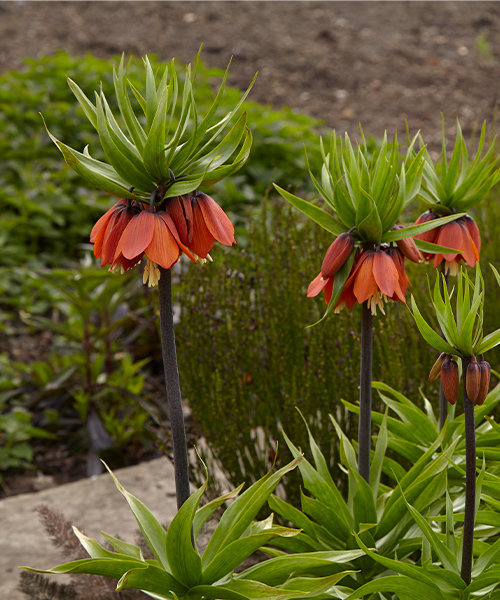
Crown imperial (Fritillaria imperialis)
Crown imperial is a spring-blooming bulb that takes dry conditions with ease. Plants grow 2 to 3 feet tall and produce clusters of long-lasting blooms in red like ‘Rubra Maxima’ pictured here, orange and even yellows found on ‘Maxima Lutea’. They look lovely mass-planted in sunny borders or woodland gardens, and add a touch of exotic flare to the landscape.
This bulb is perfectly happy with a long dry summer without any extra watering and can be susceptible to root rot if it receives too much moisture.
If you notice a strong musky sent when you’re planting the bulbs and when they flower, there’s nothing wrong — that’s just how they smell! A big benefit to this unpleasant odor is that deer, rabbits and voles tend to give crown imperial a pass. Although the flowers are rather pungent and great for preventing unwanted pests, the nectar is highly attractive to pollinators.
Care tip
Foliage begins to go dormant by midsummer. Cut it to the ground and refrain from watering that spot to prevent bulbs from rotting.
Type Bulb Blooms Red, orange or yellow flowers in late spring to early summer Light Full sun to part shade Soil Average, well-drained Size 24 to 40 in. tall, 10 to 12 in. wide Hardiness Cold hardy in USDA zones 5 to 8 Source High Country Gardens, highcountrygardens.com, 800-925-9387
You Might Also Like:
How to Plant Bulbs
How to Buy the Best Flower Bulbs
See What's New from Garden Gate Magazine
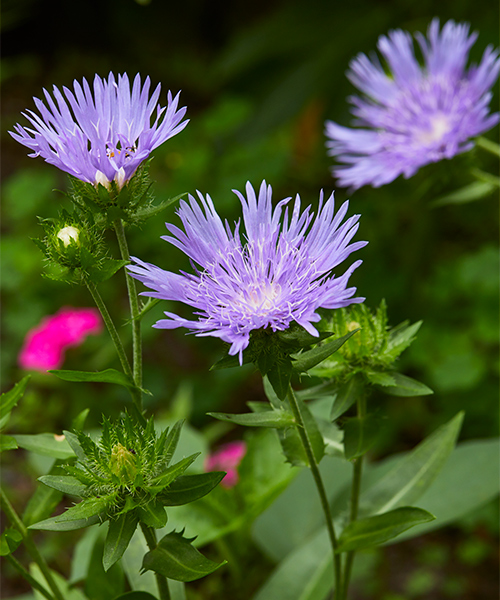
Stokes’ aster (Stokesia laevis)
Even when it’s hot and dry, Stokes’ aster looks great. The violet-blue blooms of ‘Blue Frills’ pictured here is the most common flower color, but you can also find pink ‘Wyoming’, white ‘Silver Moon’ and yellow ‘Mary Gregory’.
This perennial works wonderfully in borders or grown in containers and is perfectly suited for tough planting sites. It can also serve as a lovely part of a wildflower, butterfly or cut flower garden. Flowers will hold up for about a week after cutting.
Unfortunately, rabbits tend to favor Stokes’ aster, so you may want to avoid this perennial if that’s a problem for you or use chicken wire fencing for protection. After flowers are done blooming, deadhead to encourage more blooms.
Type Perennial Blooms Purple, pink, white, yellow or lavender-blue flowers summer to fall Light Full sun to part shade Soil Slightly acid, well-drained Size 12 to 24 in. tall, 12 to 18 in. wide Hardiness Cold hardy in USDA zones 4 to 10 Source Local garden centers

Bougainvillea (Bougainvillea hybrids)
If you’re looking for a tough, drought-tolerant vine with lots of versatility, height and color, bougainvillea is exactly what you need. This fast-growing vine is a flowering machine in sunny spots and is native to arid climates, so it’s no surprise that plants do well in heat and drought.
Train one as a standalone tree or grow it on a trellis, over an arbor or on a fence like the impressive specimen shown here. There are even a few low-growing, shrubby varieties, such as ‘Vera Deep Purple’ and ‘Singapore Pink’, which only reach a few feet tall and can be grown in containers.
The papery “flowers” are modified leaves, or bracts, that are long-lasting and bright. The colorful bracts outshine the plant’s true (but tiny) flowers and come in a variety of colors.
In cooler climates, established vines can withstand a light frost, but you’ll need to bring them indoors for winter where temperatures drop below 25 degrees F.
Type Woody vine Blooms Purple, red, pink, yellow, orange, white, burgundy, or magenta flowers in spring until frost Light Full sun Soil Well-drained Size 2 to 40 ft. tall, spreading Hardiness Cold hardy in USDA zones 9 to 12 Source Local garden centers
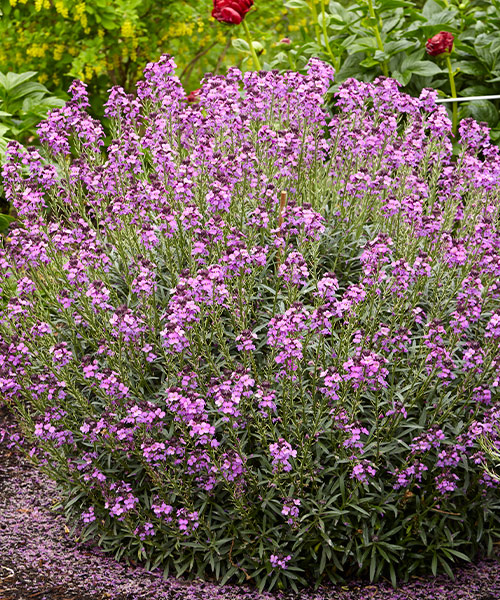
Wallflower (Erysimum spp. and hybrids)
Clusters of orange, yellow, lavender or red flowers provide spring to fall color and have a wonderful honey fragrance. Wallflowers are quite versatile because they tolerate a range of soil pH, are extremely drought resistant, and grow well in spots where other plants might have a difficult time getting established.
The silvery green foliage won’t be nibbled on by deer and rabbits, and the long-lasting flowers attract all kinds of pollinating insects and hummingbirds. For orange flowers and lush green foliage, try ‘Apricot Twist’; add a splash of yellow with ‘Walberton’s Fragrant Sunshine’, or opt for the dramatic purple hues of ‘Bowles’s Mauve’ pictured here.
Type Perennial Blooms Orange, yellow, lavender or red flowers in early spring to mid-summer Light Full sun to part shade Soil Medium to dry, well-drained Size 10 to 18 in. tall, 6 to 18 in. wide Hardiness Cold hardy in USDA zones 7 to 10 Source Local garden centers
You Might Also Like:
Problem-Solving Gardening Books
Five Drought-Tolerant Lawn Replacements
Grow a Drought-Tolerant Border with 'Millenium' Allium










